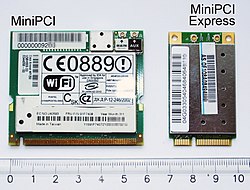 Mini-SATA, which is distinct from the micro connector, was announced by the Serial ATA International Organization on September 21, 2009. Applications include netbooks and other devices that require a smaller solid-state drive. The connector is similar in appearance to a PCI Express Mini Card interface, and is electrically compatible; however, the data signals (TX±/RX± SATA, PETn0 PETp0 PERn0 PERp0 PCI-express) need connection to the SATA host controller instead of the PCI-express host controller. Due to the absence of a standard for quite some time, there is still some confusion around this subject. For host devices which support either an mSATA SSD or mini-PCIe card interchangeably, this application note from NXP explains how to use a PCI-express/SATA router chip. This chip is essentially a four-channel bi-directional multiplexer. The vast majority of computer motherboards however have single-purpose headers which may support one of either an mSATA SSD or mini-PCIe card, but not both interchangeably. The fit-PC3 with board revision 2.3 supports 1 Mini-PCIe/mSATA device internally. Earlier fit-PC3 boards only support mini-PCIe.
Mini-SATA, which is distinct from the micro connector, was announced by the Serial ATA International Organization on September 21, 2009. Applications include netbooks and other devices that require a smaller solid-state drive. The connector is similar in appearance to a PCI Express Mini Card interface, and is electrically compatible; however, the data signals (TX±/RX± SATA, PETn0 PETp0 PERn0 PERp0 PCI-express) need connection to the SATA host controller instead of the PCI-express host controller. Due to the absence of a standard for quite some time, there is still some confusion around this subject. For host devices which support either an mSATA SSD or mini-PCIe card interchangeably, this application note from NXP explains how to use a PCI-express/SATA router chip. This chip is essentially a four-channel bi-directional multiplexer. The vast majority of computer motherboards however have single-purpose headers which may support one of either an mSATA SSD or mini-PCIe card, but not both interchangeably. The fit-PC3 with board revision 2.3 supports 1 Mini-PCIe/mSATA device internally. Earlier fit-PC3 boards only support mini-PCIe.PCI Express Mini Card
 PCI Express Mini Card (also known as Mini PCI Express, Mini PCIe, and Mini PCI-E) is a replacement for the Mini PCI form factor, based on PCI Express. It is developed by the PCI-SIG. The host device supports both PCI Express and USB 2.0 connectivity, and each card may use either standard. Most laptop computers built after 2005 are based on PCI Express and can have several Mini Card slots.
PCI Express Mini Card (also known as Mini PCI Express, Mini PCIe, and Mini PCI-E) is a replacement for the Mini PCI form factor, based on PCI Express. It is developed by the PCI-SIG. The host device supports both PCI Express and USB 2.0 connectivity, and each card may use either standard. Most laptop computers built after 2005 are based on PCI Express and can have several Mini Card slots.Mini PCI Express & mSATA
Despite the mini-PCI Express form factor, a mini-PCI Express slot must have support for the electrical connections an mSATA drive requires. For this reason, only certain notebooks are compatible with mSATA drives. Most compatible systems are based on Intel's Sandy Bridge processor architecture, using the Huron River platform. But for a mSATA/mini-PCI-E connector, the only prerequisite is that there is a switch which makes it either a mSATA or a mini-PCI-E slot and can be implemented on any platform.
Notebooks like Lenovo's T-Series, W-Series, and X-Series ThinkPads released in March–April 2011 have support for an mSATA SSD card in their WWAN card slot. The ThinkPad Edge E220s/E420s, and the Lenovo IdeaPad Y460/Y560 also support mSATA.
 Some notebooks (notably the Asus Eee PC, the MacBook Air, and the Dell mini9 and mini10) use a variant of the PCI Express Mini Card as an SSD. This variant uses the reserved and several non-reserved pins to implement SATA and IDE interface passthrough, keeping only USB, ground lines, and sometimes the core PCIe 1x bus intact.[12] This makes the 'miniPCIe' flash and solid state drives sold for netbooks largely incompatible with true PCI Express Mini implementations.
Some notebooks (notably the Asus Eee PC, the MacBook Air, and the Dell mini9 and mini10) use a variant of the PCI Express Mini Card as an SSD. This variant uses the reserved and several non-reserved pins to implement SATA and IDE interface passthrough, keeping only USB, ground lines, and sometimes the core PCIe 1x bus intact.[12] This makes the 'miniPCIe' flash and solid state drives sold for netbooks largely incompatible with true PCI Express Mini implementations.
Also, the typical Asus miniPCIe SSD is 71 mm long, causing the Dell 51 mm model to often be (incorrectly) referred to as half length. A true 51 mm Mini PCIe SSD was announced in 2009, with two stacked PCB layers, which allows for higher storage capacity. The announced design preserves the PCIe interface, making it compatible with the standard mini PCIe slot. No working product has yet been developed.
Intel has numerous Desktop Boards with the PCIe x1 Mini-Card slot which typically do not support mSATA SSD. A list of Desktop Boards that natively support mSATA in the PCIe x1 Mini-Card slot (typically multiplexed with a SATA port) is provided on the Intel Support site.
資料來源: http://en.wikipedia.org/wiki/Serial_ATA
http://en.wikipedia.org/wiki/PCI_Express
沒有留言:
張貼留言